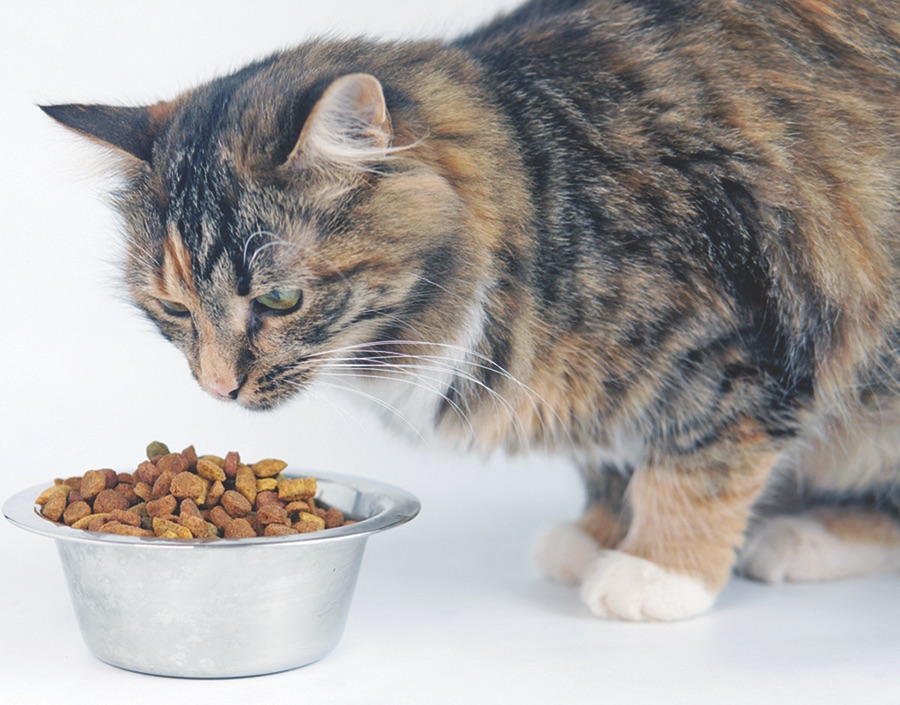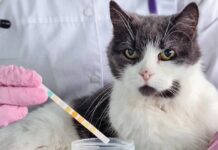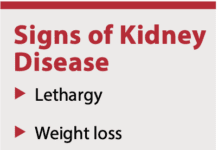If your cat has been diagnosed with kidney disease, your veterinarian probably recommended a prescription diet. These foods can be expensive, and you need a prescription to purchase them. You may find yourself wondering if they’re absolutely necessary. Do they really make a difference?
Yes, they do. Prescription diets are specially formulated to meet the unique needs of cats with chronic kidney disease (CKD), the most common kidney ailment. CKD is a progressive disease with no cure.
A cat with CKD slowly loses kidney function over time, commonly resulting in advanced kidney failure. Studies show that restricting protein, sodium, and phosphorus, while increasing water-soluble vitamins, fiber, and antioxidants, benefits cats with CKD.
The right dietary changes can help CKD cats feel better and live longer, although you may have a little leeway on when to make the transition.
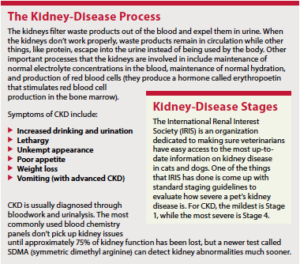
“It really depends on the stage of the disease,” says Dr. Joseph Wakshlag, DVM, PhD, DACVSMR, DACVIM, section chief of the nutrition service at Cornell University’s College of Veterinary Medicine. “There is still a lot of debate about whether a diet change is absolutely necessary during stage 1 of the disease, but, in my opinion, there is enough evidence that you might want to consider an early renal disease diet that is a little richer in protein and then use a more restricted phosphorus and protein diet in the later stages, for sure,” says Dr. Wakshlag.
Diet Does Make a Difference
Diet has been used to treat CKD for a long time. The goal is to support the damaged kidneys by providing adequate hydration and minimizing waste buildup in the bloodstream, so the kidneys don’t have to work as hard.
Keeping your cat well-hydrated can be achieved by feeding canned food, adding water to dry kibble, and/or offering more water sources, such as a cat water fountain or additional water bowls.
Modification of specific nutritional elements also plays a role in helping support her failing kidneys, including:
- Protein: As the kidneys fail, protein is lost in the urine and waste products may remain in the bloodstream, causing your cat to feel sick. Restricting protein in your cat’s diet helps reduce both the buildup of waste products associated with their metabolism in the bloodstream and the loss of needed proteins in the urine. Basically, by giving the diseased kidneys less work, they are better able to keep up.
- Phosphorus: You cat needs phosphorus to function, but too much of it can damage the kidneys. Normally, your cat’s kidneys just eliminate excess phosphorus, but damaged kidneys struggle to do this. Restricting the phosphorus in the diet helps control blood levels.
Frankly, phosphorus levels are a major reason why you can’t feed a cat with kidney disease a regular over-the-counter food. “The AAFCO minimum is to provide minimally 125 mg/100 kcals (calories) of phosphorus, and many foods are in the 200 or above range,” says Dr. Wakshlag. AAFCO is the Association of American Feed Control Officials, a private, non-profit group that determines required nutrient levels for animal foods. AAFCO recommendations target healthy animals, not those battling disease.
“There are a few foods out there that claim to be for kidney disease in cats, but they still comply with AAFCO regulations for commercial foods,” says Dr. Walshlag, “so they are in the 130 to 150 mg/100kcal range, which is lowish, but we are often looking to get to the 90 to 110 mg/100 kcal range for phosphorus for cats with CKD.”
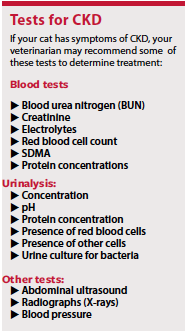 The source of phosphorus in the diet also may be important even for healthy cats. “Right now, there is a lot of interest in soluble phosphorus forms in diets,” says Dr. Wakshlag. “Typically, phosphorus comes from animal-based proteins, yet some manufacturers are using some phosphate salts in the diets, and these are very rapidly absorbed, unlike phosphorus from protein sources or things like bone meal.
The source of phosphorus in the diet also may be important even for healthy cats. “Right now, there is a lot of interest in soluble phosphorus forms in diets,” says Dr. Wakshlag. “Typically, phosphorus comes from animal-based proteins, yet some manufacturers are using some phosphate salts in the diets, and these are very rapidly absorbed, unlike phosphorus from protein sources or things like bone meal.
“This rapidly absorbable form of phosphorus may not be ideal for cats,” he says. “Most manufacturers don’t use these since the higher protein cat foods will have plenty of phosphorus. But these soluble forms can be found in treats and certain foods on the market. It is probably good to avoid foods that label a source of phosphorus in the food that is coming from a chemical form until we know more about how this truly affects cats with kidney disease.”
Sodium: Salt increases blood pressure, which puts extra stress on the kidneys. Cats are most likely to encounter excess salt in treats. If your cat has kidney disease, avoid cheese, deli meats, and some commercial cat treats. When choosing a treat from the pet store, check the salt content on the label. The Clinical Nutrition Service at Tufts University recommends a maximum of 1 mg sodium per calorie for pets with kidney disease.
Water-Soluble Vitamins and Minerals: Because cats with CKD tend to urinate more, they can lose water-soluble vitamins and minerals in their urine. This can lead to deficiencies in things like B vitamins and potassium. B vitamins are usually included in prescription diets to help ensure your cat gets everything she needs, and there are potassium supplements available if needed.
Fiber: Soluble fiber helps keep the intestines functioning at their best. While this might not sound relevant to kidney disease at first, everything is connected. Soluble fiber helps to support normal gut bacteria, which helps with both metabolism and the immune system. It also helps to prevent and alleviate constipation, which can be a complication for cats with CKD, as they have a tendency to become deydrated.
Antioxidants: Omega-3 fatty acids from fish oil have shown some promise to help support the kidneys, but more research is needed. It is often included in prescription kidney diets. And your veterinarian may recommend supplementing additional omega-3s.
Prescription Food Options
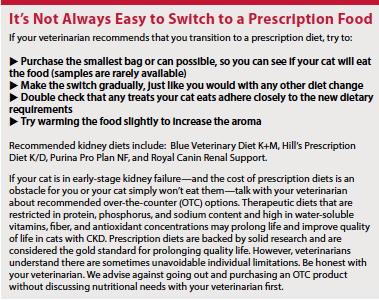 Most veterinarians recommend a canned prescription kidney diet for cats with CKD and other kidney ailments. These diets have the ideal nutritional makeup for kidney health and include more moisture to help with hydration.
Most veterinarians recommend a canned prescription kidney diet for cats with CKD and other kidney ailments. These diets have the ideal nutritional makeup for kidney health and include more moisture to help with hydration.
We all know that cats can be particular about what they will and won’t eat. Most prescription kidney diets come in several different flavors and textures. If your cat isn’t crazy about one brand, there are a couple others you can try. And, usually, you can ask about a refund for the prescription food that your cat didn’t like. While a canned food is the top choice, dry food diets are acceptable, too, for those cats that prefer kibble.
Bottom Line
If your cat has been diagnosed with CKD, prescription diets are important. While a cat in early kidney disease may OK with a more standard diet, a prescription diet with restricted phosphorus and restricted protein for cats with more advanced disease.
That said, dietary changes are most helpful when they start early, so it is important to catch CKD as quickly as possible. Regular bloodwork for senior cats is the best way to spot kidney damage before it becomes advanced.

